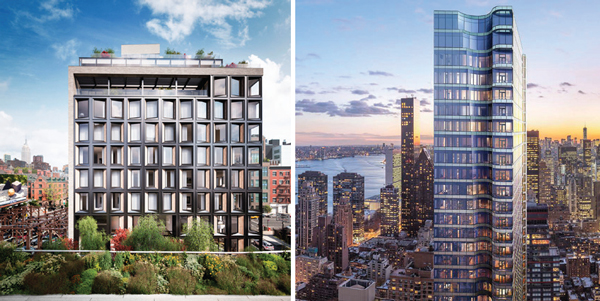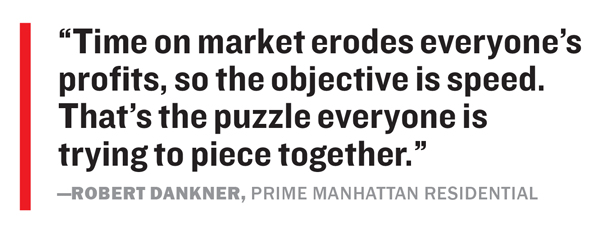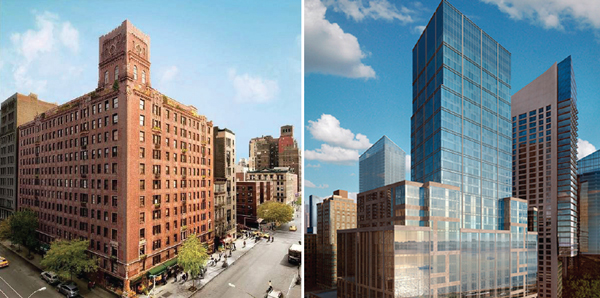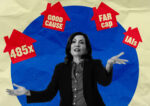Trending
Solving NYC’s condo riddle
With bank deadlines looming and carrying costs mounting, </br>developers scramble to pencil out condos planned</br> in a far different (and stronger) market

UPDATED, Aug. 3, 2:35 p.m.: The breakup of Linda and Harry Macklowe after 58 years of marriage became quick tabloid fodder. With a vast real estate empire and a billion-dollar art collection to divide, one of the more salacious details to emerge from their split was that Harry’s then-girlfriend (and now fiancée) was living at 737 Park Avenue — his condo conversion several years in the making that’s only now nearing the finish line.
Whether the love nest could have been tucked away in the building had units sold faster, however, is still up for debate.
But the project isn’t the only one that’s taking a long, maze-like path to completion.
Three years after the condo boom swept through New York, developers citywide are sitting on unsold units. And their timing seems to be far more precarious than Macklowe’s was.
Since 737 Park opened in 2013, developers have poured thousands of new Manhattan condo units onto the market. In 2017’s second quarter, condo inventory in the borough stood at around 5,900 — up 35 percent year over year, according to Halstead Property Development Marketing (HPDM). And prices for new condos are significantly down amid a slowdown in luxury sales.
For developers who already have skin in the game, the numbers are alarming, particularly since many penciled out their projects several years ago, when the market was on a (seemingly) unstoppable upswing.
To be sure, the sector is not in the dire state it was during the last recession, when buyers attempted to back out of contracts en masse and developers citywide resorted to converting full condo buildings to rentals. But lawyers, brokers and developers who talked to The Real Deal all acknowledged that there is cause for real concern.
While there are no public numbers quantifying the outstanding (and soon-to-be-due) debt on New York condo projects, it’s undoubtedly in the billions.
Nikki Field of Sotheby’s International Realty said the pressure from lenders has ramped up in the past 18 months as the market has struggled to absorb a glut of new units.
“The banks are calling in, and developers have got to deliver. They have deadlines to hit for signed contracts, they have pressure,” she said. “The longer [a project] goes, the more it costs developers. There’s a real sense of urgency to move product.”
Manhattan-based real estate attorney Terry Oved agreed. “The clock is ticking,” he said. “You have bank obligations.”
And it’s not just banks turning up the heat. The private equity funds that ramped up lending when traditional banks pulled back are also under the gun, because their funds have strict timelines that cannot be extended.
“Remember that a lot of this equity is high-octane equity — they have to give them back the money with a return,” added one developer.
That unease has prompted some developers to turn to a variety of strategies to curtail financial damage and salvage profits, including cutting prices, dangling concessions, selling blocks of unsold units and seeking inventory loans, which use sponsor apartments as collateral.

HFZ Group’s 505 West 19th Street, and Rose Associates and World Wide Group’s 252 East 57th Street
The financial conundrum, sources say, is most acute at condos that hit the market several years ago and are now 50 percent sold or more — with closings already underway and owners moving in. That’s the point at which developers start shouldering carrying costs for the unsold units in addition to paying back their lenders.
“The real impact of the slowdown in sales … is that it may require capital infusions,” said marketing consultant Nancy Packes.
While it’s difficult to know how many projects are caught in that quagmire, sources say the numbers are rising.
And the monetary burden is heavier on the high end — both because the cost of running those buildings is higher (think rooftop pools and high-end fitness centers that need staffing) and because they often take longer to sell.
“If you’re an ultrahigh-net-worth individual and own five homes, you don’t need another,” Packes said.
Behind closed doors, this new reality has led to something of a standoff between developers and their lenders — who may have competing interests.
On the one side are lenders, whose top priority is getting paid back (with interest) on time. On the other side are developers who often want to hold out for higher prices to maximize profits.
David Blatt, CEO of investment banking firm CapStack Partners, said both sides are more anxious than they were a year ago.
“What is unsettling is that we’ve been in such a long bull run relative to history,” he said. “Inevitably, the music has to stop.”
Getting to the closing table
Most of the new condos that developers are trying to unload today were conceived in a starkly different market when buyers were first jumping back into the real estate game. To meet that renewed interest, developers were scrambling to get condos out of the ground.
But some are now questioning whether that development blitz went too far.
Related: Who’s winning condo marketing’s game of musical chairs
In 2015, roughly 6,500 new condos were unleashed in Manhattan — nearly triple the 2,500 units launched the year before. As of last count this year, there were nearly 6,000 units on the market.
Developers are already seeing a slowdown in deal volume — new-development contracts dropped 23 percent during the second quarter, according to HPDM.
“Every developer is worried,” said one sponsor who asked to remain anonymous to avoid inciting further concern in the market.
“A developer has to sell — the entire project hinges upon one thing: selling and hitting the numbers,” added the sponsor.
That, however, is easier said than done.
Broker Dolly Lenz said some buyers who signed contracts before the market turned are now trying to renegotiate.
“We’re seeing some buyers … bringing in big guns like law firms and asking [brokers] to do all types of market data analysis, and they are getting a discount,” she told a room full of residential brokers at TRD’s annual Showcase & Forum in May.
According to appraiser Jonathan Miller, some buyers who signed contracts in 2014 or 2015 are now sitting on units that are worth 20 to 25 percent less on average than the prices they agreed to pay.
“Buyers willing to pay 2014 prices are in short supply,” he said. “If the developer doesn’t come down to meet the buyer, there is no sale.”

For those developers trying to avoid prices cuts so that they can maintain comps at their buildings, a host of other concessions are in play to ensure that buyers make it to the closing table.
“They’re giving closing costs, storage, maybe some parking,” said Compass’s Toni Haber. “They’re trying to [maintain] the prices. It gives the sponsor more leverage on people paying more in the future.”
The tug-of-war over prices and concessions can be traced directly back to how much developers and their backers have spent on these projects to begin with.
Many developers bought land at the top of the market around 2015 — when prices for developable dirt in Manhattan hit a record $1,200 per square foot. Although they made those purchases — and obtained loans — under the assumption that they’d be able to sell condos for premium prices, that reality has been turned on its head.
“Many find that even after they sell out completed buildings, they’re not going to make money — or could lose money — because the construction costs were higher, debt costs have gone up, and sales prices have corrected 22 percent,” said Andrew Heiberger, the CEO of Town Residential.
Between 2013 and 2015, construction costs did indeed jump by 5 percent, and last year those expenses increased by another 4 percent, according to the New York Building Congress.
A first line of defense for many developers is to shake up their marketing teams.
That’s what Forest City New York and Greenland USA did just last month at their 278-unit Brooklyn condo 550 Vanderbilt, where sales started strong but slowed to a trickle last year. Two years after launching, the project is about 65 percent sold.
Still, the developers have refused to cut prices at the tower because they’ve counting on the building to establish a high price bar for other buildings at their Pacific Park megaproject.
“We’ve made a deliberate decision to hold at a certain point, because it’s going to set the market — not just for the building — but the neighborhood we’re invested in,” said MaryAnne Gilmartin, president and CEO of Forest City’s New York office.
That could come as welcome news to 550 Vanderbilt’s early buyers. Generally speaking, those who’ve snapped up units early can get jittery if the rest of the apartments in a building don’t move fast, fearing that the sponsor will cut prices or start renting out units, making it tougher to refinance and sell.
Buyers at 100 Barclay Street — Magnum Real Estate and CIM Group’s 157-unit condo that launched in 2015 — have been anxious to see the building sold out, brokers said. The developers were not available for comment, but so far 89 units have closed, according to public records.
“I had many of them calling saying, ‘Now what?’” said Corcoran Group’s Vickey Barron, who marketed the building when she was at Douglas Elliman and has also represented buyers there.
Barron said she told them not to worry. She also explained that the toughest time to sell a building is midconstruction.
“It’s like catching a woman with curlers in her hair,” she said. “Then the curlers come off, and it’s like, ‘She’s beautiful!’”
Mitigating risk or eating profits?
For lenders, a building that gets stuck at the half-sold mark raises major red flags.
While banks typically don’t want to get paid back too quickly — interest payments drive earnings, after all — they also don’t want developers to exercise their option to extend loans (which generally run between two and seven years) to, say, 10 years.
“Lenders are about risk mitigation,” said David Eyzenberg, who launched an eponymous Manhattan-based real estate investment bank last year. “They want a certain chunk of them sold. You don’t want to be sitting on a broken property as collateral.”
While developers can typically repay their loans once the project is half sold, most lenders collect a portion of the proceeds from each individual sale. “Certainly lenders are running the analysis of how many units need to be sold and closed to be repaid in full,” said CapStack’s Blatt.
Some lenders have become more aggressive in the last few months about pushing developers to make compromises.
“The lender can cross their arms and say, ‘Go sell it for a lower price,’” said Robert Dankner, co-founder of Prime Manhattan Residential, who has worked on a number of new development deals.
But because dropping prices ultimately cuts into sponsors’ profits there’s often pushback on that.
Generally, sources say, sponsors aim to be 40 percent sold by the time closings start.
Put another way: A developer who discounts prices by 20 percent will be able to pay back the debt, but there isn’t enough money for the developer to hit their promote — their share of profits.

Cheshire Group and Sterling American Property’s Devonshire House condo conversion and Extell Development’s One Riverside Park
As a result, some developers have reason to wait for the market to improve.
“While the developer is banking on absorption picking up, the expense of the deal is reducing the overall profitability, which is typically in the last 30 percent of sales,” said Robin Schneiderman, HPDM’s director of new business development.
Specific terms of the deal and the developer’s cost basis, of course, dictate the course of action.
To contend with slow sales at 252 East 57th Street, which launched sales in 2014, World Wide Group and Rose Associates opted to cut asking prices and began offering higher-than-average commissions to buyers’ brokers.
In addition, this year, Gary Barnett’s Extell Development shaved 10 percent off asking prices at five of the remaining eight apartments at the 68-unit Carlton House, a condop on East 61 Street. The developer did the same for unsold units last year at the 219-unit One Riverside Park, which launched in 2013.
Meanwhile, in January, developer Ziel Feldman’s HFZ Capital Group and his private equity partner, the Carlyle Group, came to an unusual agreement at 505 West 19th Street, where four sponsor units were lingering on the market.
When Feldman resisted cutting prices, Carlyle paid HFZ $44.1 million for the condos and then relisted them for sale. It’s since sold one of the units for $14.7 million, a $700,000 discount from its most recent price and about 23 percent less than its original 2014 asking price of $19 million.
Other investors are assessing their options as anxiety spreads.
At a May meeting of about 40 Israeli bondholders who have bankrolled projects like One57 and One Manhattan Square, some expressed concern about Extell’s ability to repay its debt, sources told TRD.
The bondholders were pushing to force Extell to immediately pay them back — even though the first $180 million payment isn’t due until December 2018.
The building, which has only unloaded four of its remaining 47 sponsor units so far this year, has already seen two owners fall into foreclosure. That kind of distress is never good for values in the building or the surrounding market.
Just down the block on Billionaires’ Row at 111 West 57th Street, developers Michael Stern and Kevin Maloney are battling one of their own investors, Ambase Corporation, which alleges that project is facing a $100 million shortfall.
JDS Development Group and Property Markets Group announced in March 2016 that they were delaying sales to better time the market.
The developers have denied a shortfall, blamed Ambase for holding their refinancing hostage and said they’re relaunching sales this fall.
The heavy cost of carrying a building
Developers with half-sold buildings know they must move fast.
In addition to paying interest on the construction loan, common charges for unsold units can set a developer back $2 to $4 per square foot.
And those fees can add up.
At One Riverside Park, the monthly carrying cost for a six-bedroom penthouse currently listed for $16.5 million is $6,910 — or $82,920 a year.
At 252 East 57th Street, World Wide Group and Rose budgeted $11.8 million to cover the building’s first year of operation, according to an offering plan filed with the state attorney general’s office. That sum included an estimated $360,000 to maintain the fitness center and pool, $116,000 for security and $1.5 million to pay the building’s 26 staffers, including lobby and elevator attendants, porters, handymen and a resident manager.
Over the past 18 months, an increasing number of developers have gotten more aggressive.
In an effort to reduce his debt at Madison Square Park Tower, his 82-unit condo at 45 East 22nd Street, developer Bruce Eichner considered a $125 million inventory loan to help repay $340 million in construction financing from Goldman Sachs, according to news reports.
But he managed to jump-start sales at the building — which hit the market in 2014 and has recently been stalled at around 75 percent sold — and avoid that lifeline.
Last month, Eichner also took concession-making to the next level, announcing that he’d throw in two studio apartments and two parking spots for any buyer willing to shell out $48 million for the building’s 7,000-square-foot penthouse. (According to StreetEasy, the monthly carrying cost for the unit is an estimated $25,500 — or about $306,00 a year.)
Although Eichner avoided an inventory loan, Macklowe and others have gone down that road.
Macklowe landed a $52.8 million inventory loan in April 2016 from First Republic Bank for the commercial unit and 11 unsold condos at 737 Park. The project had closed about 88 percent of its units as of last month, and a representative for the developers said only two units are left to sell.
Aaron Appel, a managing director at JLL and co-head of the real estate investment banking practice, said inventory loans are on the rise in New York as sponsors look to lower financing costs and then “take out additional leverage at a cheaper rate, and be able to pull out some of the equity from the deal.”
Unlike during the last recession, when developers triggered their Plan B — converting condo buildings to rentals — this time around most developers have a cost basis that’s too high to do that.
Compounding matters is that even the priciest rentals and condos are vastly different, said Town’s Heiberger.
“The problem with underwriting as a rental is that the unit mix has to be different,” he said.
In addition, there’s softness in the rental market — as Extell discovered at One57. The developer attempted to rent 38 lower-floor units but shifted gears when that didn’t work. It then shopped them as a bulk condo offering for $250 million before reimagining them as “midmarket” units in April 2016, starting at $3.5 million.
Bulk offerings are, however, making their way into the market, too.
Last year, under orders from their lender, Cheshire Group and Sterling American Property sold a block of 33 rent-regulated units at their Devonshire House condo conversion in Greenwich Village to Aby Rosen’s RFR Realty for $32 million.
The developers had already converted 70 of the building’s 131 units, and they planned to wait out the market and then convert the rest. But the lender pressed the shot-clock buzzer.
“The [developers] said, ‘Look, we’re crying, but equity says to sell,’” recalled Mark Zborovsky, whose eponymous firm brokered the sale. “With equity funds, the life of the fund expires and it doesn’t matter whether the market is great or terrible, they have to complete the fund.”
It’s nice to have deep pockets
Not every developer is racing the clock.
Those with a low basis may be able to ride out the current market, especially if it means capturing higher prices during the next upswing.
Zeckendorf Development — whose 50 United Nations Plaza is not sold out after four years — is said to underwrite projects in such a way that they’re not penalized if a building takes longer to sell. A spokesperson for 50 United Nations Plaza told TRD that over 70 percent of the apartments are sold and that the building is debt-free.
In addition, while developers aren’t converting projects to rentals wholesale, some are leasing unsold units while they wait out the current market.
Unable to sell three penthouses at the Flynn, a 30-unit condo in Chelsea, developer IGI-USA listed the units as rentals this spring with asking prices ranging from $28,000 to $33,000 a month.
Meanwhile, Kushner Companies found a renter this year who was willing to pay $70,000 a month for one of the six penthouses at the top of the Puck Building.
“If you have deep pockets, you can do that,” said Compass President Leonard Steinberg.
In some cases, lenders also see the virtue of waiting.
“I don’t want to leave somebody at the end of the cliff,” said Shawn Safdie, managing director of S3 Capital, a private lending platform associated with Spruce Capital Partners that has backed small and midsized condos in Brooklyn. “We know construction can take longer than expected.”
The investors backing 160 Leroy and 111 Murray are also holding out. Both buildings have a handful of units remaining, including some penthouses.
There’s very little benefit for them to rush sales, said Elliman’s Michael Graves.
“They’re basically saying, ‘We can’t deliver for two and a half to three years. Why are we rushing sales now when we can get bigger and higher prices down the line?’” he said.
And the softness in today’s market isn’t scaring all lenders off. Some are already betting on New York’s next economic cycle.
Sources speculated that JPMorgan Chase is doing that with the $900 million construction loan it has agreed to give to Extell for the developer’s Central Park Tower project, which will have 20 units priced at $60 million or more.
Until then, nobody is “giving away the store,” said Prime Manhattan’s Dankner.
“But time on market erodes everyone’s profits, so the objective is speed,” he said. “That’s the puzzle everyone is trying to piece together.”
Correction: An earlier version of this story stated JPMorgan Chase provided a $950 million loan to Extell. The bank has agreed to provide a $900 million loan.
To view or purchase a list of the 100 largest residential buildings in development, ranked by their number of units, click below
NYC’s 100 Largest Residential Projects in Development Free Sample
NYC’s 100 Largest Residential Projects in Development
NYC’s 100 Largest Residential Projects in Development – PREMIUM Free Sample
NYC’s 100 Largest Residential Projects in Development – PREMIUM
Contact Derek Smith at ds@therealdeal.com with any questions regarding TRData.




